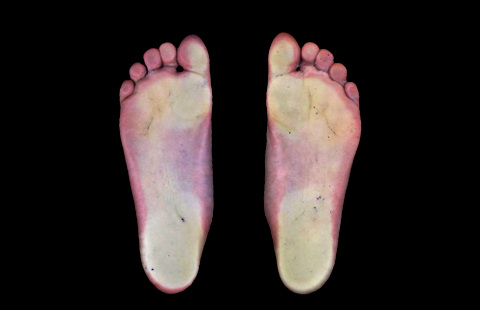:: flat feet
» Pronated foot, pronated heel, knock ankles, rotation at heel, pronation, excess pronation, hyper-pronation
Pronated heels usually precede and contribute to the development of flat feet. It is a common preschool developmental stage in children. As of age three to five, it is, however, considered a deformity, which can be corrected by exercises, proper shoes and orthotic insoles. Pronated heels are most common deformity in children. The opposite condition is supination, i.e. varus deformity of the heel.
» Flat feet, fallen arches, lowered arch, pes planus, pes planovalgus
It is the most common foot deformity known. The causes are numerous: rapid growth, weak ligaments, overweight, genetics, tight Achilles tendon, walking barefoot on hard and flat grounds (at home) and improper shoes. It is manifested by dull pain, heavy feet, burning feet and excessive leg fatigue. People are seldom born with this deformity. It is acquired as we grow and it can therefore be corrected by proper shoes, orthotic insoles and exercises, if initiated early enough. The success rate depends on the severity of the condition and age.
Exercises for Flat Feet (Never overdo these exercises, especially with younger kids, contact your podiatrist first to instruct you on which to begin with and to tell you the precise time you spend with each.) Exercises for flat feet in PDF format.
You can also search for inspiration and ideal therapy on YouTube, just check the video below. Feel free to leave out those that are very hard for you at the very beginning. En pointe or dancing on folded toes are not your goal. Warm-up, exercise, and stretch or do a relaxing foot massage at the end. Once or up to three times a day for ten minutes. With adults, it strenghtens up the arch and ligaments, with kids up until the age of 6-8, it will also help recover fallen arches and knock ankles.
» Dropped metatarsals, plantar-flexed metatarsals
Dropped metatarsals are developed by straining forefoot, i.e. wearing improper shoes as well as putting on weight. Some people are genetically more predisposed then others. By the same way, it can also occur as result of weight gain in pregnancy. It is frequently accompanied by flat feet. The pain is most prominent in the forefoot (in the ball), i.e. in between the second and fourth metatarsal joints. It is accompanied by burning feet, sharp pains hitting the ball and tiredness. If not treated in time, excessive built up of skin or calluses may occur. A timely and properly designed orthotic insole with a metatarsal pad will provide a relief or significantly reduce the symptoms. A large proportion of ortho-prosthetic companies are not able to put the meta pad (t-pad) in the correct position. Therefore, it is not uncommon that clients declare zero effect of this correction. Some other companies will even try to lure you into buying orthotics without the meta pad and will insist on it being redundant. They usually label these products as hi-tech and tell stories about locking the Chopart's joint. Nevertheless, from our point of view, these are only stock or off-the-shelf products from Asia with brilliant marketing and bright shiny colors. It is precisely this meta pad that makes their production complicated (i.e. more expensive), since its position is defined by the individual foot length and sometimes a remarkable difference between the right and left foot. If your metatarsals are dropped, these insoles are not suitable for you. If the insole including the metatarsal pad is designed well, the relief comes in two weeks of wearing it and the pain can fade away entirely in a month. The first symptoms of dropped metatarsals with our clients are mostly recorded between the ages of 25-35.





